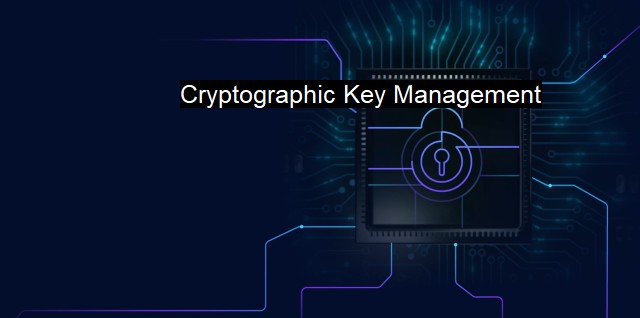What is Cryptographic Key Management?
The Critical Role of Cryptographic Key Management in Cybersecurity: Protecting Sensitive Data and Ensuring Online Authentication
In the expansive world of cybersecurity and antivirus protection, processes and measures are undertaken to ensure the safeguarding of digital information. One crucial aspect of achieving this security is through Cryptographic Key Management. This phenomenon can be otherwise known as key management in a cryptographic context, but regardless of its exact nomenclature, what remains is a procedural necessity in modern, technological security efforts.Cryptographic Key Management is essentially the management of cryptographic keys in an accessible cryptographic system. These keys are important components in maintaining digital safety and operate much like physical keys, unlocking something that was locked and providing access to information. In a cryptographic context, the 'key' can decrypt the 'locked' or encrypted data, only when the right 'key' is used.
Cryptographic keys are utilized in various encryption algorithms designed to secure digital data. These algorithms work by providing two corresponding keys: a private key known only to the recipient of the information and a public key that can be widely distributed. The sender uses the recipient’s public key to encode the message, which can only be decoded by the recipient’s private key. The soundness of the system is contingent upon the private key remaining confidential.
Implementing and managing these cryptographic keys is an intricate process that spans their entire lifecycle from generating, distributing, storing, rotating, replacing, and eventually, retiring these cryptographic keys. The process can be even more intricate based on the number of keys, the frequency of their use, their diversification, and their tenure/lifespan.
The management of cryptographic keys is a critical aspect that predicates successful data protection. Poor or ineffective key management can lead to unauthorized data exposure and compromises upon businesses’ cyber-structures. Given enough determination and resources, an unauthorized individual may gain access to the cryptographic key, thereby accessing the classified or private information it is supposed to safeguard - a situation akin to a thief procuring a physical key.
In efficient key management systems, keys are frequently changed, ensuring that even if an unauthorized individual discovers a key, the timeframe within which they can exploit this access is restricted. Thus meaning, by the time they attempt to infiltrate the system, the key may already have been altered, averting potential system disruptions or data violation.
Implementing a key management system that ensures that keys are secure, inaccessible to unauthorized individuals, and regularly updated or rotated, can drastically enhance the security of a digital system. It can prevent harmful intrusions, like malicious software or hackers who attempt to exploit weak or out-dated keys, thereby preventing unauthorized access.
Managing cryptographic keys also plays a functional role in system recovery after system-wide failures or security breaches. Appropriate key storage and systematic cycling of keys amongst end-users can help in the swift retrieval of data and a smoother transition back to regular operations.
Cryptographic Key Management acts as a fundamental bulwark of security architecture within the digital landscape. It emphasizes that the mere application of cryptographic techniques is not enough to secure data, but the method of controlling and extensively managing cryptographic keys holds significant bearing over the successful implementation of these techniques. Protecting these cryptographic keys is akin to protecting the keys of a vault, testifying to the critical role of efficient Cryptographic Key Management in achieving cybersecurity excellence.

Cryptographic Key Management FAQs
What is cryptographic key management?
Cryptographic key management refers to the process of securely generating, storing, distributing, and revoking encryption keys. It is an essential aspect of cybersecurity and antivirus software to ensure the confidentiality, integrity, and authenticity of sensitive data.Why is cryptographic key management important?
Cryptographic key management is vital because encryption keys are the foundation of any cryptographic system. If the keys fall into the wrong hands, sensitive data can be compromised, and the consequences could be catastrophic. Proper key management ensures that the keys are protected throughout their lifecycle, from generation to disposal.What are some best practices for cryptographic key management?
Some best practices for cryptographic key management include using strong encryption algorithms to generate and protect keys, restricting access to keys through role-based access control, regularly rotating keys to prevent attacks, and securely erasing keys when they are no longer needed. It's also important to have a well-defined key recovery process so that the keys can be regained in case they are lost or compromised.What are some challenges in implementing cryptographic key management?
Implementing cryptographic key management can be challenging because it requires a significant amount of coordination and planning. Key management must be integrated into the overall cybersecurity strategy and aligned with the organization's risk management framework. Other challenges include the need for a secure and reliable key storage infrastructure, managing the lifecycle of keys across distributed systems and applications, and complying with industry regulations and standards.| | A | | | B | | | C | | | D | | | E | | | F | | | G | | | H | | | I | | | J | | | K | | | L | | | M | |
| | N | | | O | | | P | | | Q | | | R | | | S | | | T | | | U | | | V | | | W | | | X | | | Y | | | Z | |
| | 1 | | | 2 | | | 3 | | | 4 | | | 7 | | | 8 | | |||||||